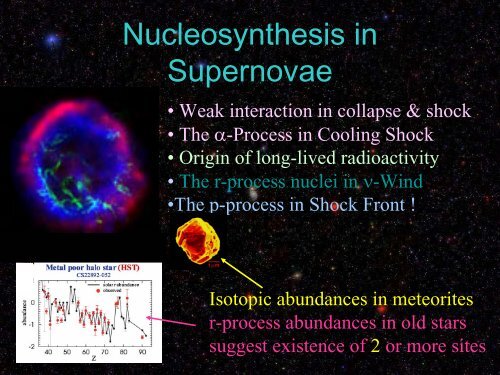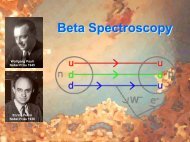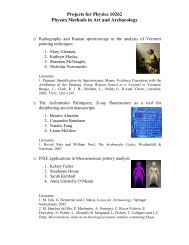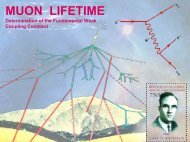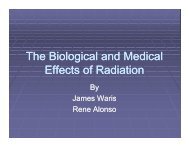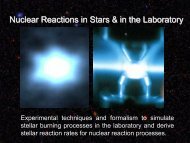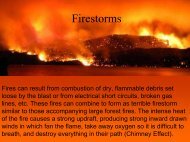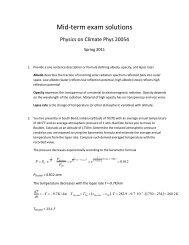10) Nucleosynthesis in Supernovae - ISNAP
10) Nucleosynthesis in Supernovae - ISNAP
10) Nucleosynthesis in Supernovae - ISNAP
You also want an ePaper? Increase the reach of your titles
YUMPU automatically turns print PDFs into web optimized ePapers that Google loves.
<strong>Nucleosynthesis</strong> <strong>in</strong><br />
<strong>Supernovae</strong><br />
• Weak <strong>in</strong>teraction <strong>in</strong> collapse & shock<br />
•The α-Process <strong>in</strong> Cool<strong>in</strong>g Shock<br />
• Orig<strong>in</strong> of long-lived radioactivity<br />
• The r-process nuclei <strong>in</strong> ν-W<strong>in</strong>d<br />
•The p-process <strong>in</strong> Shock Front !<br />
Isotopic abundances <strong>in</strong> meteorites<br />
r-process abundances <strong>in</strong> old stars<br />
suggest existence of 2 or more sites
Weak <strong>in</strong>teraction dur<strong>in</strong>g collapse phase
Effects of Nuclear<br />
Electron Capture<br />
dur<strong>in</strong>g Core Collapse<br />
The electron capture at high<br />
densities results <strong>in</strong> lower Y e and<br />
generates neutr<strong>in</strong>o w<strong>in</strong>d which is<br />
necessary for driv<strong>in</strong>g the shock.<br />
Hix, Messer, Mezzacappa, et al ‘03
Shock front simulations <strong>in</strong> terms of<br />
electron abundance Y e and entropy S
Emergence of shock and fallback<br />
Mass cut
Equilibrium at high T conditions<br />
A-1<br />
X+n<br />
A-4<br />
Y+ 4 He<br />
At high temperatures equilibrium<br />
between all reaction channels<br />
can occur! Moreover through<br />
these <strong>in</strong>teractions Statistical equilibrium nuclei develop<br />
equilibrium with excited abundance states ratios<br />
s<strong>in</strong>ce they are <strong>in</strong> equilibrium<br />
with all other nuclei !<br />
Y<br />
B<br />
G<br />
Z , N<br />
Z , N<br />
Z , N<br />
=<br />
G<br />
Z , N<br />
A<br />
X<br />
⋅<br />
( ρ ⋅ N )<br />
A−1<br />
≡ b<strong>in</strong>d<strong>in</strong>g energy<br />
≡ partition function<br />
A<br />
⎛<br />
⋅<br />
⎜<br />
⎝<br />
2<br />
2π<br />
⋅h<br />
m ⋅ kT<br />
u<br />
⎞<br />
⎟<br />
⎠<br />
3<br />
⋅<br />
2<br />
( A−1)<br />
⋅e<br />
−<br />
B<br />
Z , N<br />
kT<br />
⋅Y<br />
N<br />
n<br />
⋅Y<br />
Z<br />
p
Y<br />
Z , N<br />
Abundance conditions <strong>in</strong> equilibrium<br />
=<br />
G<br />
Z , N<br />
( ρ ⋅ N )<br />
High ρ: massive nuclei<br />
High T: light nuclei<br />
Intermediate T: High<br />
abundance for nuclei with<br />
high b<strong>in</strong>d<strong>in</strong>g energy.<br />
With decl<strong>in</strong>e of shock<br />
follows a change of<br />
abundance distribution.<br />
⋅<br />
A<br />
A−1<br />
log Abundance<br />
<strong>10</strong><br />
⎛<br />
⋅<br />
⎜<br />
⎝<br />
0<br />
-5<br />
-<strong>10</strong><br />
-15<br />
2<br />
2π<br />
⋅h<br />
m ⋅ kT<br />
u<br />
NSE <strong>in</strong> Si-Burn<strong>in</strong>g<br />
n<br />
n<br />
⎞<br />
⎟<br />
⎠<br />
3<br />
⋅<br />
2<br />
α<br />
p<br />
( A−1)<br />
log Abundance<br />
<strong>10</strong><br />
⋅e<br />
-20<br />
-20<br />
0.8 0.6 0.4 0.2 0.0 -0.2 0.8 0.6 0.4 0.2 0.0 -0.2<br />
log T log T<br />
<strong>10</strong> 9<br />
9<br />
0<br />
-5<br />
-<strong>10</strong><br />
-15<br />
S N<br />
kT<br />
⋅Y<br />
N<br />
⋅Y<br />
Z<br />
p<br />
56Ni<br />
28Si<br />
40Ca<br />
24Mg<br />
<strong>10</strong><br />
44Ti
Explosive burn<strong>in</strong>g <strong>in</strong> shock front<br />
Initial dissociation towards p, n, 4 He<br />
Re-association is stat. equilibrium towards 56 Ni
Dynamical Reaction Network<br />
α-Process<br />
Mass 5 Gap<br />
Mass 8 Gap<br />
r-process ?
Temperature and density <strong>in</strong> shock<br />
Exponential<br />
decl<strong>in</strong>e for<br />
T and ρ with<br />
shock expand<strong>in</strong>g<br />
<strong>in</strong>to outer layers
Supernova shock front nucleosynthesis
Build up of N=Z nuclei from 28 Si, 44 Ti, 56 Ni up to 64 Ge
Supernova Shock Front<br />
Complex mix<strong>in</strong>g of nucleosynthesis patterns<br />
How far up <strong>in</strong> mass does nucleosynthesis proceed?
Supernova light curve 1987 A
Galactic 56 Ni and 44 Ti<br />
radioactivity<br />
⎥<br />
⎦<br />
⎤<br />
⎢<br />
⎣<br />
⎡<br />
=<br />
⋅<br />
= −<br />
Δ<br />
=<br />
=<br />
=<br />
⋅Δ<br />
+<br />
+<br />
t<br />
bol<br />
bol<br />
e<br />
L<br />
L<br />
L<br />
L<br />
M<br />
T<br />
dt<br />
dM<br />
d<br />
T<br />
d<br />
T<br />
Fe<br />
Co<br />
e<br />
Ni<br />
λ<br />
ν<br />
β<br />
ν<br />
1<br />
2<br />
2<br />
1<br />
1/2<br />
1/2<br />
1/2<br />
56<br />
56<br />
56<br />
;<br />
log<br />
2.5<br />
0.755<br />
77.7<br />
6.1<br />
)<br />
(<br />
)<br />
,<br />
(
Galactic radioactivity as SN<br />
nucleosynthesis signature<br />
44<br />
Ti and 60 Co radioactivity can be used to determ<strong>in</strong>e mass
44<br />
Ti observations
44<br />
Ti & 60 Co <strong>in</strong> light curve of<br />
SN1987A
Possible consequences of high<br />
neutr<strong>in</strong>o flux <strong>in</strong> shock-front<br />
Neutr<strong>in</strong>o capture on protons<br />
1<br />
H(ν + ,e + )n, neutron production<br />
which <strong>in</strong>fluence the reaction<br />
path by neutron capture.
νp-process <strong>in</strong> hydrogen rich, high<br />
neutron flux environments<br />
On-site neutron production<br />
through neutr<strong>in</strong>o <strong>in</strong>duced<br />
<strong>in</strong>teraction: 1 H(ν + ,e + )n!<br />
By-pass<strong>in</strong>g wait<strong>in</strong>g<br />
po<strong>in</strong>t nuclei 64 Ge,<br />
68<br />
Se by n-capture<br />
reactions.
Production of light p-nuclei<br />
Production of light p-nuclei <strong>in</strong> this model depends strongly on<br />
Y e (e - abundance)<br />
radial position r of νp-process site<br />
entropy S (~T/ρ) <strong>in</strong> shock


